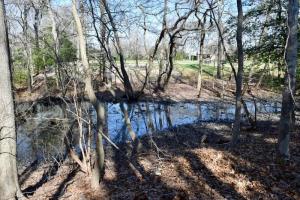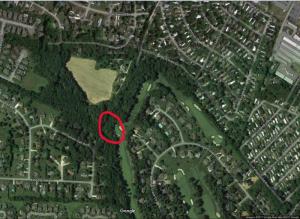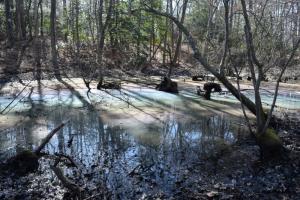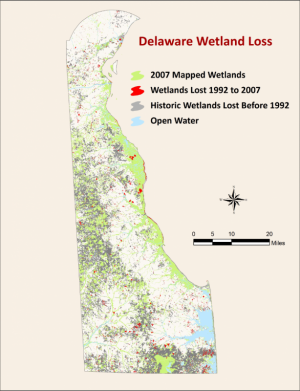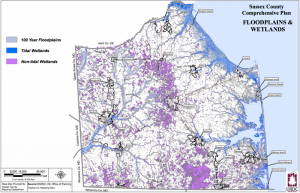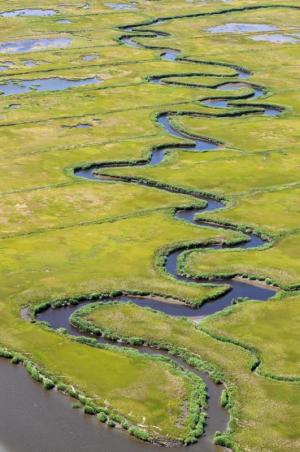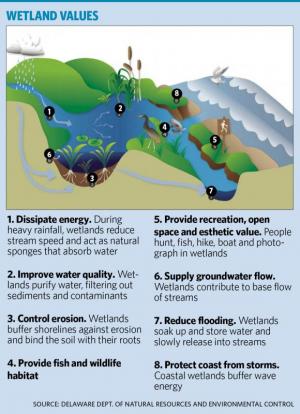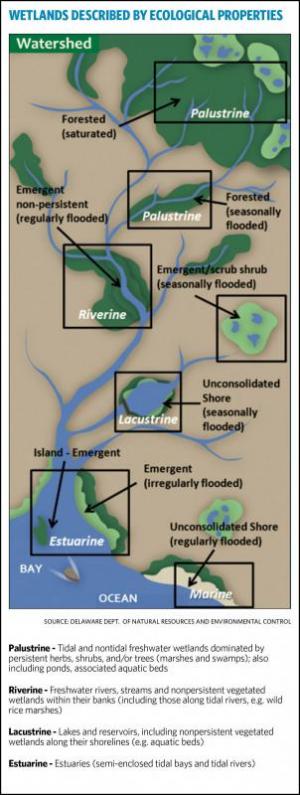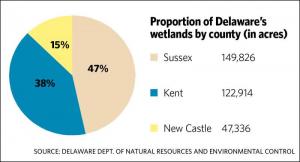Nearly a decade ago, when state officials tried to impose buffers along Inland Bays waterways, Sussex County fought for the right to make its own land-use decisions.
Sussex County won that battle in court, but years later, Sussex still has not established minimum buffers to protect the state’s most common type of wetlands.
That became clear to one local resident after he noticed workers had hacked down brush along the back nine of Kings Creek Country Club's golf course.
The neighbor was concerned they were working too close to nearby marsh and worried they might harm an isolated wetland bordering his backyard.
He soon found out Sussex County has no minimum buffer dictating how close people can work along the edge of a freshwater wetland like the one near his home.
Delaware is one of the only mid-Atlantic states with no rules in place to protect freshwater wetlands, said Chris Bason, executive director at the Delaware Center for the Inland Bays.
“A lot of states have said they'll protect their own. But Delaware has not,” he said.“They leave that up to the feds, for better or for worse.” As for buffers on waterways, including wetlands, that's up to the counties.
Kent and New Castle counties have mandatory buffers for all waterways and wetlands, but the only regulation on the books in Sussex County calls for a 50-foot buffer along tidal waterways.
When it comes to freshwater wetlands – which are primarily nontidal and account for nearly 75 percent of all wetlands in Delaware – there are no protections in Sussex. The only exception is a buffer requirement for cluster subdivisions.
“There's been a decades-long, very heated political debate over freshwater wetlands and property rights,” Bason said, pointing to a 2008 lawsuit that challenged the Department of Natural Resources and Environmental Control's attempt to mandate buffers through the Inland Bays Pollution Control Strategy. A Superior Court judge ruled against DNREC, saying it's up to the counties to decide their own zoning and land-use policies; that decision was affirmed by the Supreme Court in 2011.
Even though in 2008, the county's comprehensive plan suggested adopting zoning regulations to mandate buffers, Sussex County still does not require buffers between freshwater wetlands and new development.
Sussex officials are now working on a 10-year update to that plan, but it remains unclear whether buffers for freshwater wetlands will be adopted.
“As far as I know, the issue of wetlands and buffers has not been discussed in the comp plan meetings of the council or P&Z,” said county spokesman Chip Guy. “I'm told that will come in the conservation chapter/element discussions, but there is no timetable for that. So giving you a forecast on what is to come with respect to this is not something we can do at this point.”
Sussex County Administrator Todd Lawson could not be reached for comment.
One of many small examples
Mark Haschemeyer, Kings Creek Country Club golf course superintendent, said even though Sussex has not established buffers, he and his staff realize wetlands are important.
“We take it pretty seriously,” Haschemeyer said. “We have a lot of property that borders wetlands. We work with the state on what we can and can't do.”
Haschemeyer said clearing brush near the Rehoboth Beach resident's home was part of ongoing maintenance work at the golf course to allow more sunlight and air flow to the green.
“That makes for healthier turf to survive summer, and we'll put fewer pesticides and chemicals down,” he said. “We don't have any intentions to do anything negative.”
Haschemeyer said where the course abuts waterways there is, at minimum, a 5-foot voluntary buffer. In some places it's 10 to 15 feet or wider, he said.
“We don't have anywhere on the course where we maintain all the way to the edge of a wetland,” he said.
Because Sussex has not established buffers around freshwater wetlands, golf course workers can do whatever they like, as long as they're not working in the wetland itself.
For that they would have to get a permit from the U.S. Army Corps of Engineers.
“It has the potential to be jurisdictional wetlands under the Clean Water Act, but [the Corps] can't commit to saying it is or isn't until they have a request by the property owner,” said DNREC environmental scientist Mark Biddle.
Small disruptions along the edge of wetlands are more common than people realize, Bason said, and that's a problem.
“The little disturbances happen all the time and nobody ever hears about it,” Bason said. “They might need a permit, they might not need a permit, but in the end, they build on the wetlands or they encroach on the wetlands.”
Wetland loss concerns scientists
It's not just wildlife habitat that is lost when people infringe on wetlands.
Freshwater wetlands, especially vernal pools that fill and drain seasonally, provide habitat for rare and endangered species in the First State, but also filter pollutants from runoff and store flood waters during storms. Wetlands' ability to filter and store water leads to improved water quality and natural flood protection for people and property.
“They're a really great place not to develop and to instead protect,” Bason said. “Most other states protect freshwater wetlands to some degree. And when you think about how poor our water quality is already, and we're destroying the wetlands that are supposed to protect the water quality, that's not good.”
From 1992 to 2007, Delaware saw a net loss of more than 3,100 acres of vegetated wetlands, according to the state's most recent wetlands status report. More than 2,900 of those acres were inland, freshwater wetlands, and 30 percent of those were lost due to development. Of those 2,900 acres lost, nearly 2,600 acres were in Sussex County.
In that same 15-year period, the Inland Bays watershed alone lost more than 1,000 acres of freshwater wetlands, Bason wrote in a 2014 letter to the Delaware Wetlands Advisory Committee.
“The tragedy of how wetlands have been managed in the past is that the governing agencies just permit a small impact here, a small impact there, and all those impacts add up and result in an overall degradation of water quality in the connecting water body,” Bason said. “It's a very short-sighted approach built into the regulatory system.”
The 2007 mapping project found there are 320,076 acres of wetlands statewide, 242,630 of which are freshwater wetlands. Sussex County is home to nearly 50 percent of all wetland types.
In 2018, DNREC will coordinate another 10-year update on the state's wetlands status based on 2017 aerial photography.
Trump order complicates protections
DNREC regulates tidal wetlands and large freshwater wetlands containing at least 400 contiguous acres, such as the Great Cypress Swamp, but it's up to the U.S. Army Corps of Engineers to regulate marshes that don't fall in those categories.
President Donald Trump’s recent executive order may complicate protection of vulnerable wetlands even more, Bason said. The order, signed Feb. 28, calls for U.S. Environmental Protection Agency Administrator Scott Pruitt and Corps leaders to rescind or rewrite former President Barack Obama's Clean Water Rule, which aimed to clearly define federal protections for water systems such as small, nontidal, freshwater wetlands and vernal pools.
“For a long time it was really uncertain, and people were impacting wetlands without knowing if they were regulated or not. The Corps didn't have much manpower to enforce that, and that's why Obama instated this rule,” Bason said. “Now the Corps is probably back in a state of confusion.”
Biddle and Bason said the Corps is stretched thin when it comes to enforcing permits or investigating violations.
“Those wetlands are really in danger,” Bason said. “I think the lack of freshwater protections – protections you do see in other counties and other states – has definitely resulted in poorer water quality and more potential for flooding.”
Fighting for wetland protection may depend on concerned citizens, like the Rehoboth Beach man who lives near the golf course. The state, county and Army Corps do not have staff to continually monitor possible infringements on wetlands, so regulatory agencies rely on people to understand the rules and, when it comes to wetlands, apply for a state or federal permit.
Other than that, average citizens need to speak up.
“When you look at surveys and polls of what the public wants, I think people want those places protected, but sometimes there are other interests that might be better represented,” Bason said. “This is a Delaware resource that affects the people of Delaware.”














.jpg)
